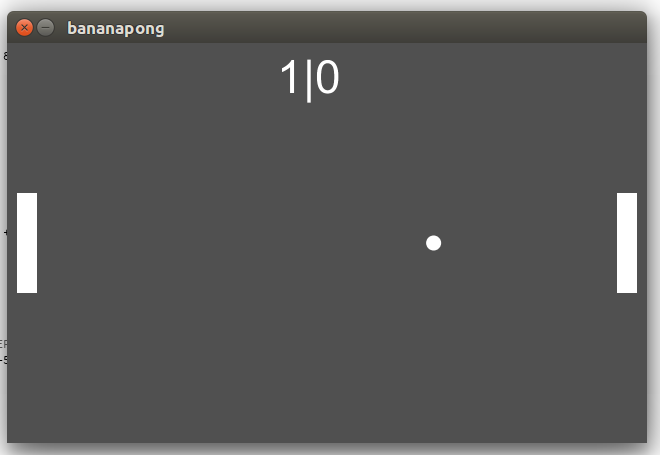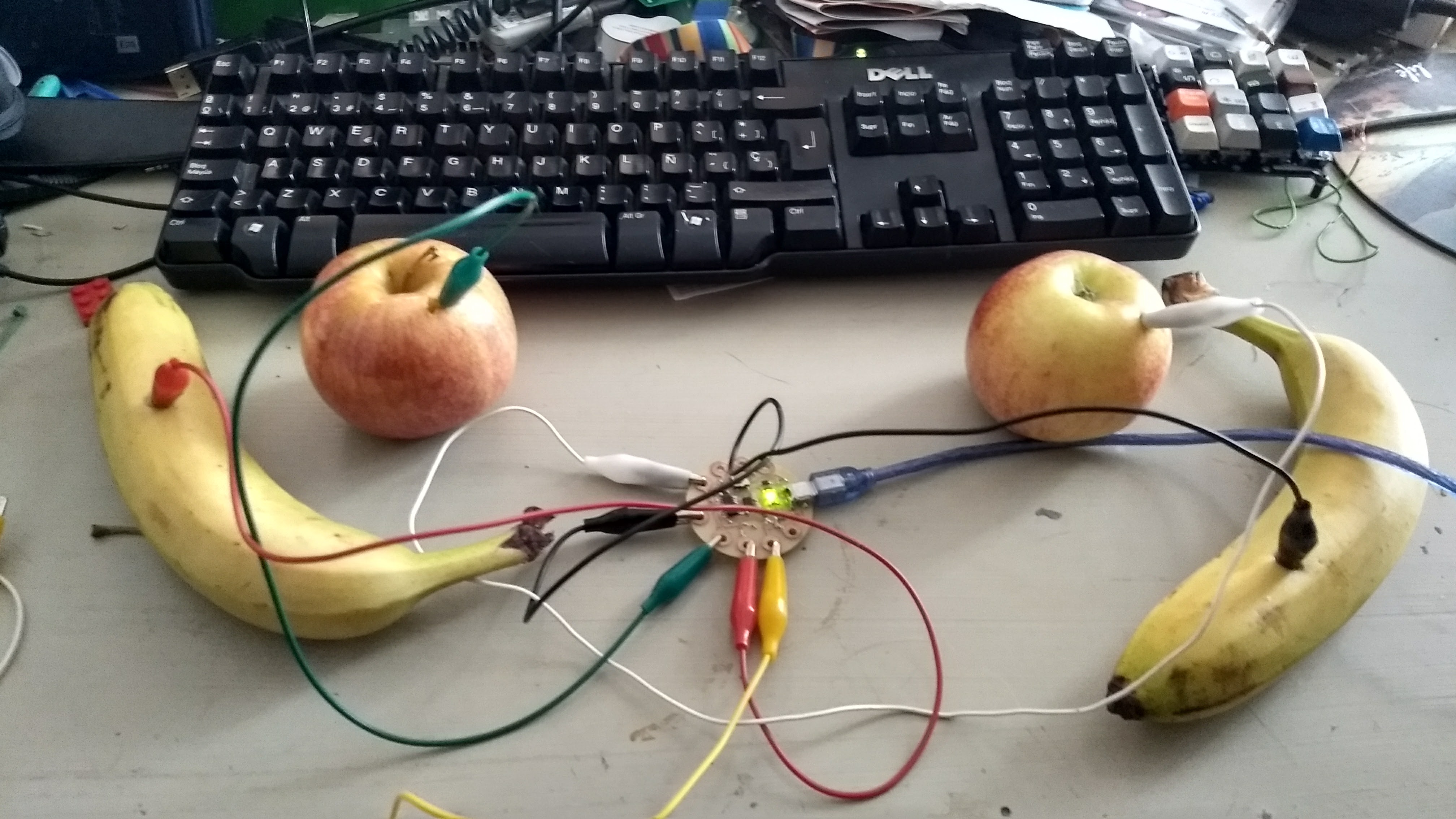Assignment
Write an application that interfaces with an input and/or output device that you made, comparing as many tool options as possible.
for this week I created a board that emulates a keyboard, and also you can use any material that is moderately conductive to activate the keyboard keys, is a simpler version of MakeyMakey, to do this I use an Atinny44 and a library that emulates the usb port v-usb, which I have already used the other assignaments.
This board is done on two sides, to be able to do this in the cnc, it is necessary to have a pair of guides and that the design is completely centered in our image, but the faces do not finish squaring.
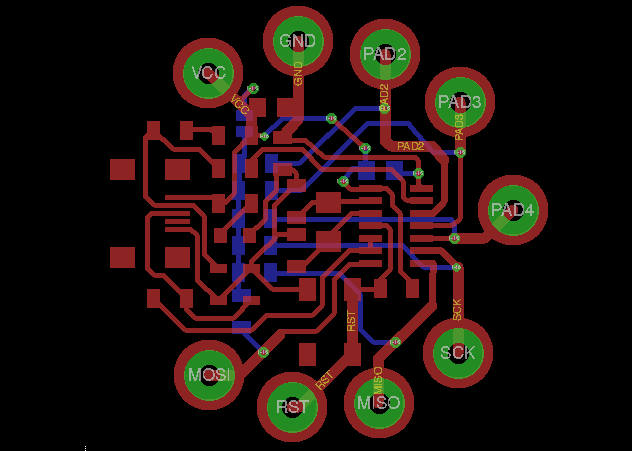
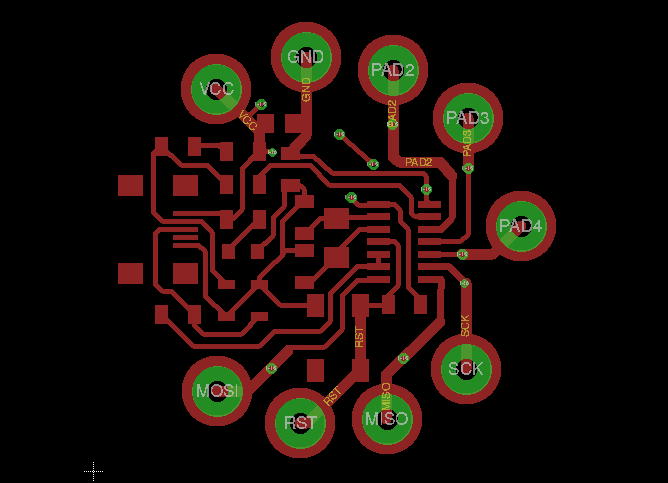
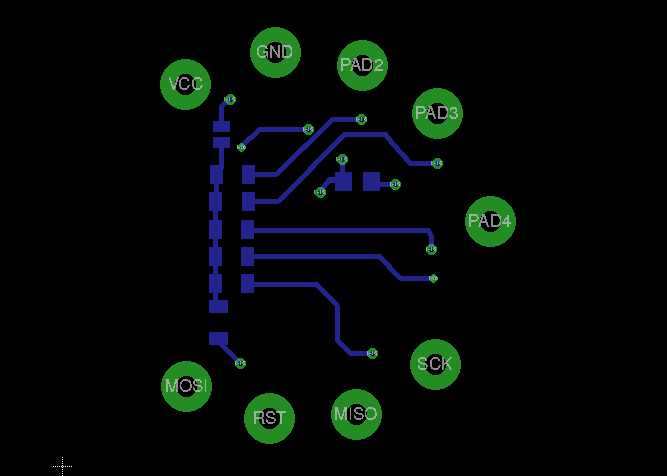
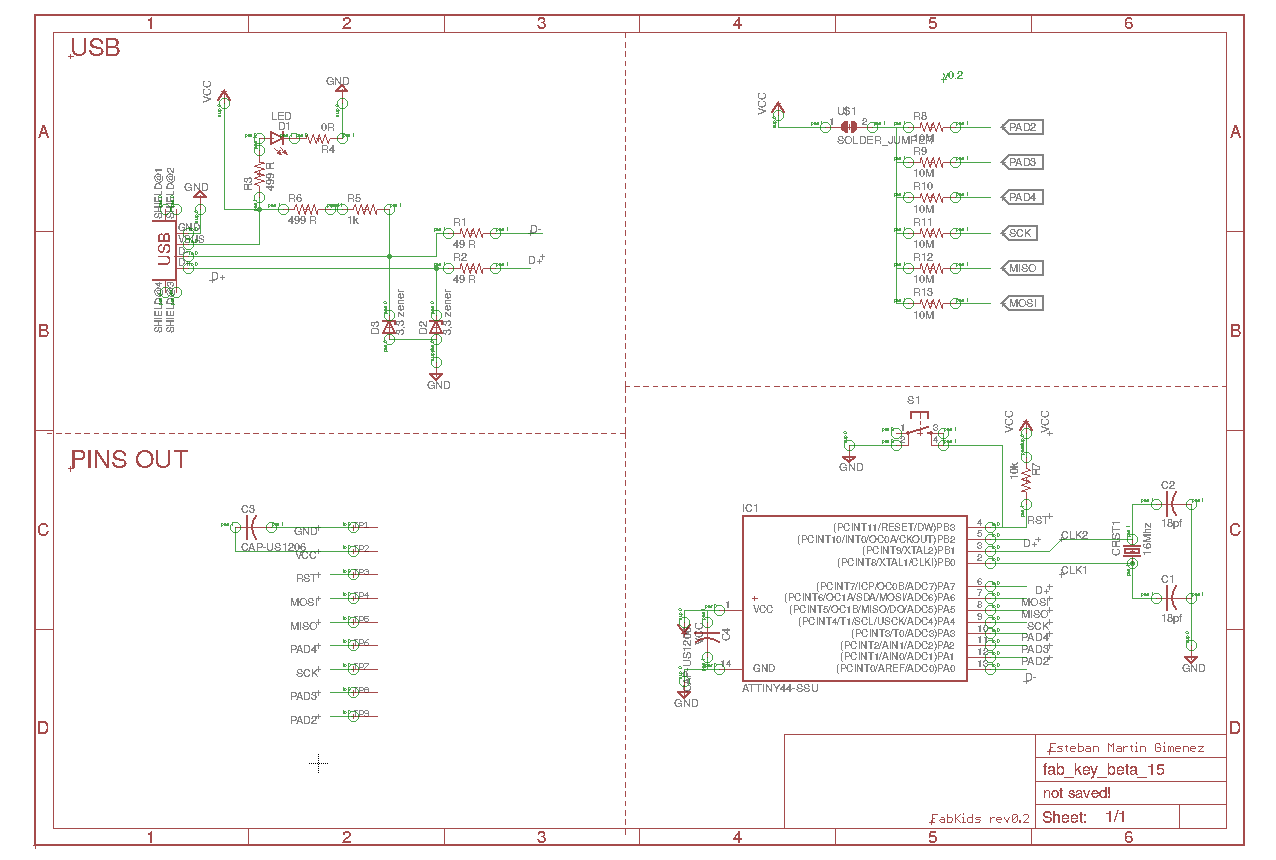
In these two images we can see how it is mapped the pins of the Attiny and the keys that I have decided to use for each output pin.
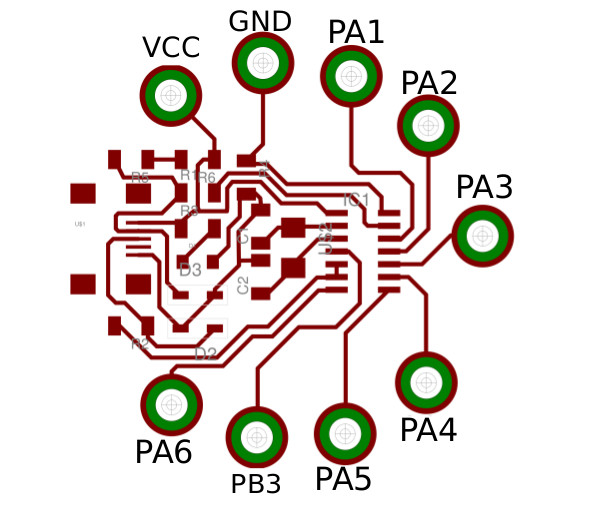
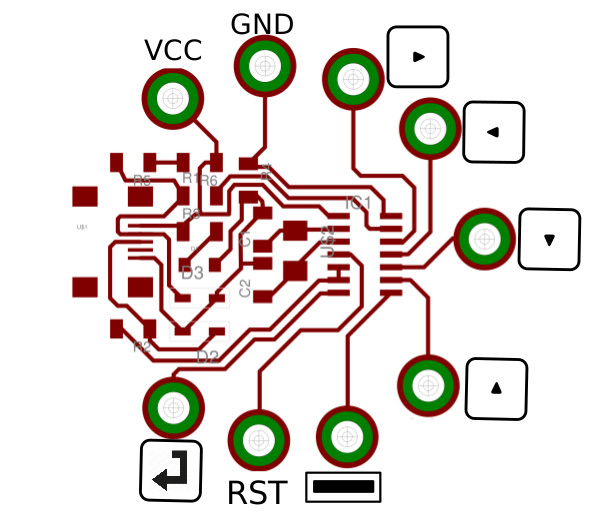
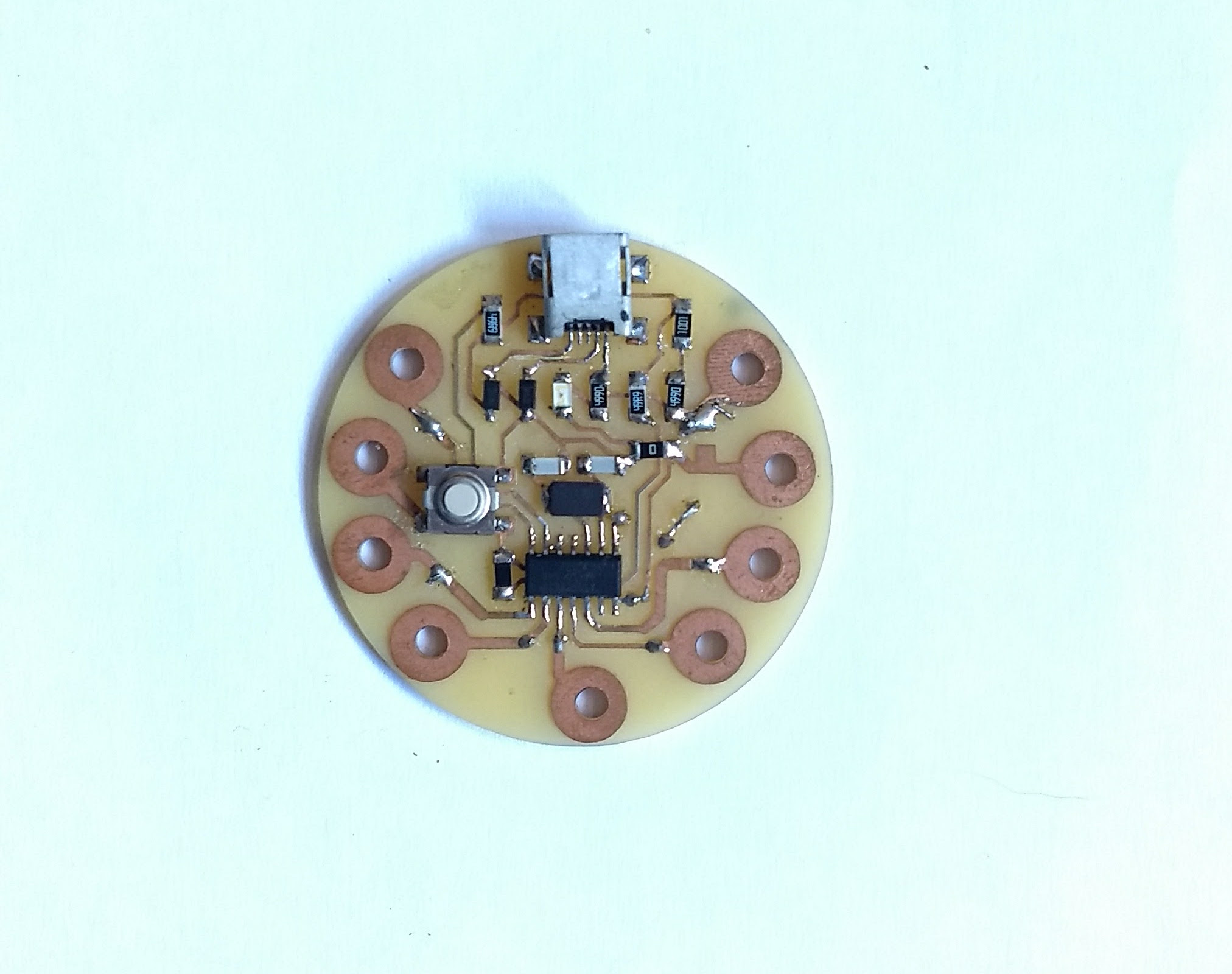
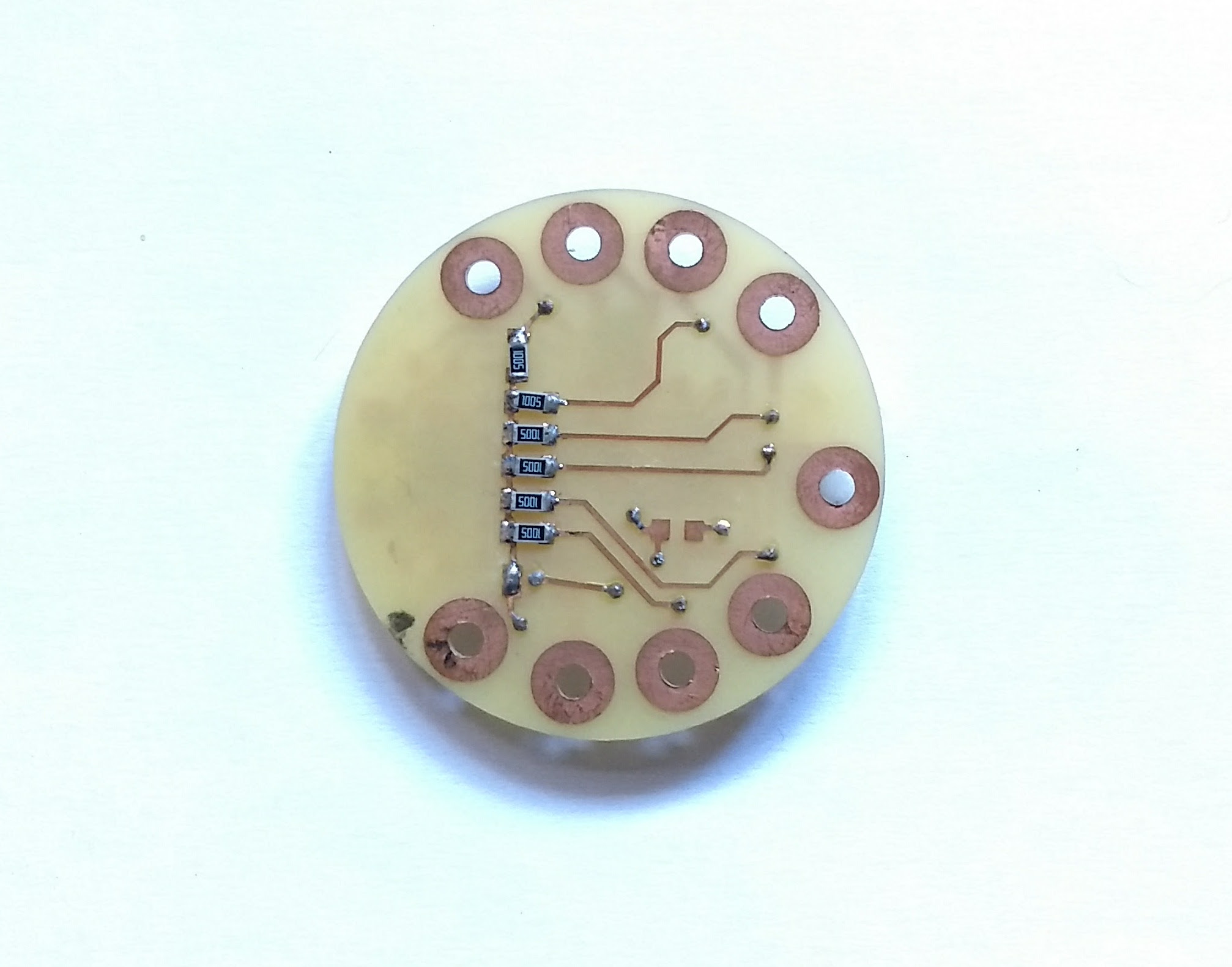
As I said before I used the library v-usb that allows to emulate a usb 2.0 connector and this ends emuladon a keyboard, we see in the code that there is a part where we indicate which keys we want to map the keyboard, changing these values we can use other keys.
1
2
3
4
5
6
7
8
9
10
11
12
13
14
15
16
17
18
19
20
21
22
23
24
25
26
27
28
29
30
31
32
33
34
35
36
37
38
39
40
41
42
43
44
45
46
47
48
49
50
51
52
53
54
55
56
57
58
59
60
61
62
63
64
65
66
67
68
69
70
71
72
73
74
75
76
77
78
79
80
81
82
83
84
85
86
87
88
89
90
91
92
93
94
95
96
97
98
99
100
101
102
103
104
105
106
107
108
109
110
111
112
113
114
115
116
117
118
119
120
121
122
123
124
125
126
127
#include <avr/io.h>
#include <avr/wdt.h>
#include <avr/eeprom.h>
#include <avr/interrupt.h>
#include <avr/pgmspace.h>
#include <util/delay.h>
#include <stdlib.h>
#include "usbdrv.h"
#include "oddebug.h"
static uchar reportBuffer[2]; /* buffer for HID reports */
static uchar idleRate; /* in 4 ms units */
static uchar reportCount=0; /* current report */
static uchar keypad[7]={0x00,0x4F,0x50,0x51,0x52,0x2C,0x28};
PROGMEM const char usbHidReportDescriptor[USB_CFG_HID_REPORT_DESCRIPTOR_LENGTH] = { /* USB report descriptor */
0x05, 0x01, // USAGE_PAGE (Generic Desktop)
0x09, 0x06, // USAGE (Keyboard)
0xa1, 0x01, // COLLECTION (Application)
0x05, 0x07, // USAGE_PAGE (Keyboard)
0x19, 0xe0, // USAGE_MINIMUM (Keyboard LeftControl)
0x29, 0xe7, // USAGE_MAXIMUM (Keyboard Right GUI)
0x15, 0x00, // LOGICAL_MINIMUM (0)
0x25, 0x01, // LOGICAL_MAXIMUM (1)
0x75, 0x01, // REPORT_SIZE (1)
0x95, 0x08, // REPORT_COUNT (8)
0x81, 0x02, // INPUT (Data,Var,Abs)
0x95, 0x01, // REPORT_COUNT (1)
0x75, 0x08, // REPORT_SIZE (8)
0x25, 0x65, // LOGICAL_MAXIMUM (101)
0x19, 0x00, // USAGE_MINIMUM (Reserved (no event indicated))
0x29, 0x65, // USAGE_MAXIMUM (Keyboard Application)
0x81, 0x00, // INPUT (Data,Ary,Abs)
0xc0 // END_COLLECTION
};
/*
0x4F Keyboard RightArrow
0x50 Keyboard LeftArrow
0x51 Keyboard DownArrow
0x52 Keyboard UpArrow
0x28 Keypad ENTER
0x2C Keyboard Spacebar
*/
static void buildReport(uchar key)
{
if(key!=0){
reportBuffer[0] = 0; /* no modifiers */
reportBuffer[1] = keypad[key];
}else
{
reportBuffer[1] =0x00;
}
}
static uchar keyPress(void) {
reportCount++;
uchar i, mask, x;
x=PINA;
mask = 1 << 1;
for (i = 0; i < 7; ++i)
{
if((x & mask) == 0)
return i+1;
mask <<= 1 ;
}
return 0;
}
/* -------------------------------------------------------------------------------- */
/* ------------------------ interface to USB driver ------------------------ */
/* -------------------------------------------------------------------------------- */
uchar usbFunctionSetup(uchar data[8])
{
usbRequest_t *rq = (void *)data;
usbMsgPtr = reportBuffer;
if((rq->bmRequestType & USBRQ_TYPE_MASK) == USBRQ_TYPE_CLASS){ /* class request type */
if(rq->bRequest == USBRQ_HID_GET_REPORT){ /* wValue: ReportType (highbyte), ReportID (lowbyte) */
buildReport(keyPress());
return sizeof(reportBuffer);
}else if(rq->bRequest == USBRQ_HID_GET_IDLE){
usbMsgPtr = &idleRate;
return 1;
}else if(rq->bRequest == USBRQ_HID_SET_IDLE){
idleRate = rq->wValue.bytes[1];
}
}else{
/* no vendor specific requests implemented */
}
return 0;
}
/* ------------------------------------------------------------------------- */
/* --------------------------------- main ---------------------------------- */
/* ------------------------------------------------------------------------- */
int main(void)
{
PORTA=0x00; //banana
uchar i,key,lastKey,keyDidChange=0,newkeyDidChange=0;
usbInit();
usbDeviceDisconnect(); /* enforce re-enumeration, do this while interrupts are disabled! */
while(--i){ /* fake USB disconnect for > 250 ms */
wdt_reset();
}
usbDeviceConnect();
wdt_enable(WDTO_1S);
sei();
for(;;){ /* main event loop */
wdt_reset();
usbPoll();
key= keyPress();
if(lastKey != key){
lastKey = key;
keyDidChange = 1;
}
if(keyDidChange && usbInterruptIsReady()){ /* we can send another key */
keyDidChange = 0;
buildReport(lastKey);
usbSetInterrupt(reportBuffer, sizeof(reportBuffer));
}
}
return 0;
}
There are infinities of framewoks to create interfaces and connect them with any type of board, my two favorites are Processing and OpenFrameworks, both with very versatile, but the difference is great, OF is programmed in C ++ so we must compile our code for different architectures that we work, in the case processing is based on java that it is possible to execute it in a virtual machine, which allows us to execute our code in any machine without compiling it.
That's why I decided to work with Processing.
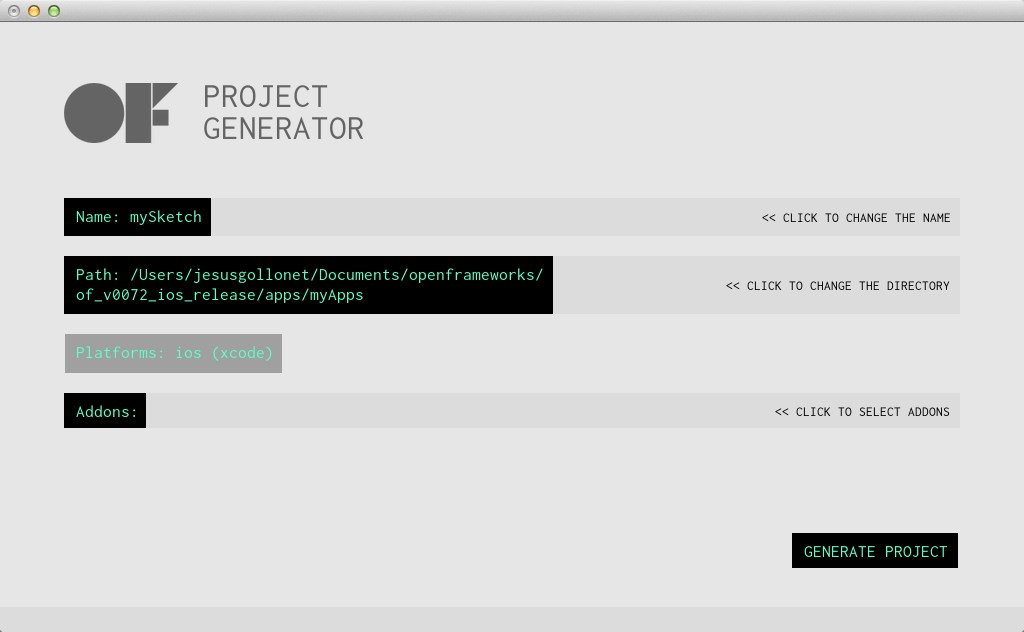
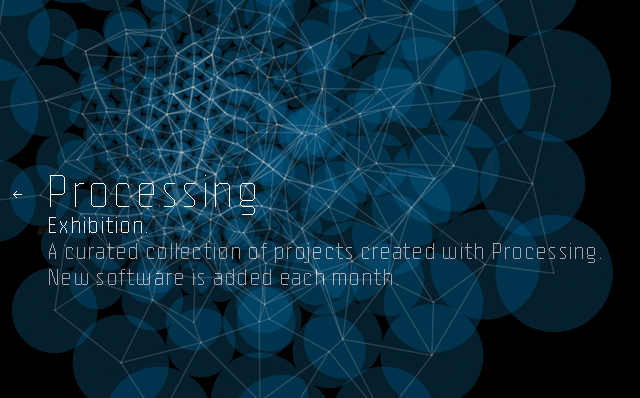
1
2
3
4
5
6
7
8
9
10
11
12
13
14
15
16
17
18
19
20
21
22
23
24
25
26
27
28
29
30
31
32
33
34
35
36
37
38
39
40
41
42
43
44
45
46
47
48
49
50
51
52
53
54
55
56
57
58
59
60
61
62
63
64
65
66
67
68
69
70
71
72
73
74
75
76
77
78
79
80
81
82
83
84
85
86
87
88
89
90
91
92
93
94
95
96
97
98
99
100
101
102
103
104
105
106
107
108
109
110
111
112
113
114
115
116
117
118
119
120
121
122
123
124
125
126
127
128
129
130
131
132
133
134
135
int size = 15;
float xpos, ypos; // Position Balls
float xspeed = random(5,6); // Balls speed X
float yspeed = random(0,4); // Balls speed Y
int player1=0;
int player2=0;
int playerpos1;
int playerpos2;
PFont f; // STEP 1 Declare PFont variable
void setup()
{
size(640, 400);
noStroke();
frameRate(30);
smooth();
playerpos1 =height/2;
playerpos2 =height/2;
xpos = 45;
ypos = playerpos1;
f = createFont("Arial",16,true); // STEP 2 Create Font
}
void draw()
{
background(80);
textFont(f,46); // STEP 3 Specify font to be used
text(player2+"|"+player1,(width/2)-50,50);
xspeed *= 1.001;
xpos += xspeed;
ypos += yspeed;
if (ypos > height-size/2 || ypos < 0+size/2)
{
yspeed *= -1;
}
if ( xpos <= 30+size/2) {
if (ypos > playerpos1-50 && ypos < playerpos1+50){
xspeed *= -1;
yspeed += (ypos-playerpos1)/5;
}
}
if (xpos <= 0){
player1 += 1;
if (player1 <= 6){
xpos = 50;
ypos = playerpos1;
xspeed = random(5,6);
//xspeed *= -1;
yspeed = 0;
textFont(f,46); // STEP 3 Specify font to be used
text(player2+"|"+player1,(width/2)-50,50);
}
}
if ( xpos >= width-30-size/2) {
if (ypos > playerpos2-50 && ypos < playerpos2+50){
xspeed *= -1;
yspeed += (ypos-playerpos2)/5;
}
}
if (xpos >= width){
player2 +=1 ;
if (player2 <= 6){
xpos = width-50;
ypos = playerpos2;
xspeed = -random(5,6);
yspeed = 0;
textFont(f,46); // STEP 3 Specify font to be used
text(player2+"|"+player1,(width/2)-50,50);
}
}
ellipse(xpos, ypos, size, size);
rect (10, playerpos1-50,20,100);
rect (width-30, playerpos2-50,20,100);
if (keyPressed) {
if (keyCode == LEFT) {
if (playerpos1 >=50)
playerpos1 = playerpos1 - 8;
}
if (keyCode == RIGHT)
{
if (playerpos1 <=height-50)
playerpos1 = playerpos1 + 8;
}
}
if (keyPressed) {
if (keyCode == UP)
{
if (playerpos2 >=50)
playerpos2 = playerpos2 - 8;
}
if (keyCode == DOWN){
if (playerpos2 <=height-50)
playerpos2 = playerpos2 + 8;
}
}
if (player1 >=6) {
player1=5;
background(80);
textFont(f,46); // STEP 3 Specify font to be used
text(player2+"|"+str(player1),(width/2)-50,50);
delay(10000);
player1=0;
player2=0;
}
if (player2 >=6) {
player2=5;
background(80);
textFont(f,46); // STEP 3 Specify font to be used
text(str(player2)+"|"+player1,(width/2)-50,50);
delay(10000);
player1=0;
player2=0;
}
}
When joining my board with this game, which is the Pong, instead of using the keyboard, I have decided that each competitor should play with a piece of fruit, and I have called it BananaPong.
The game consists of touching the corresponding steal to raise or lower the white line, the dough is to climb and the banana to go down.
Also the code is modified so that it only detects the pressing of one of the keys, being able to interfere in the game of the opponent, but also being able to harm oneself.
